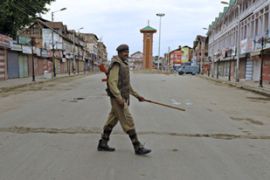Deaths in Kashmir curfew protests
Seven people reportedly killed by security forces in Indian-administered region.

Local residents claimed that the boy was beaten to death by security forces, but police said that they were investigating the cause of the death.
Omar Abdullah, the chief minister of the Jammu and Kashmir state, earlier said that enforcing a curfew was necessary to stem the violence.
“If I have been given a choice between curfew and use of force I will prefer curfew because I do not want anyone to die,” Abdullah said.
Suppressing unrest
Abdullah met Manmohan Singh, India’s prime minister, and other government officials in New Delhi to discuss how to defuse the recent unrest.
Paramilitary and police forces have been mobilised in large numbers across the disputed Himalayan region.
| IN VIDEO | |||||||||
|
“The need is to end the cycle of violence. Some semblance of normalcy has to be a precursor for any political initiative,” Abdullah said.
Kashmiri Muslims, who complain the the security forces use excessive violence, have held massive street protests, attacked security camps with rocks and burned police stations.
Government forces have responded by using live ammunition and tear gas to break up the protests.
In the northern village of Kralpora, protesters set a security bunker on fire and ransacked a counterinsurgency police force camp, a police officer said.
Troops opened fire, injuring eight protesters, three critically, he said.
Protesters also burned a government building and a local intelligence office in Budgam, a town to the west of Srinagar, the region’s main city.
Four protesters were wounded there, the officer said.
The other injuries occurred in other clashes throughout the region, the officer said.
Decades of violence
In Srinagar, troops announced over public address systems mounted on their vehicles that stern action would be taken against those violating the curfew.
However, hundreds of protesters came out on the streets in several neighbourhoods, chanting “Go India, Go back” and “We want freedom”.
 |
| A judicial probe has been ordered into the recent spate of police shootings [AFP] |
Troops fired warning shots and tear gas to disperse the protesters, the police officer said.
The recent tension in the Himalayan region – divided between India and Pakistan and claimed by both – is reminiscent of the late 1980s, when protests against New Delhi’s rule sparked a conflict that has since claimed around 68,000 civilian lives.
Decades of on-off political dialogue about the status of the disputed territory have yielded few rewards and no end to the deadlock. This has bred frustration among the residents.
The violence on Friday and Saturday was focused on the northern district of Baramulla, a traditional hotbed of Muslim separatism in the valley. It spread to south Kashmir on Sunday.
Nazir Shawl, a Kashmir analyst that supports an independent Kashmir, told Al Jazeera that the conflict does not get due international attention.
“Yesterday was a bloody Sunday in Indian-occupied Kashmir. I personally feel that Kashmir is an ignored conflict and the international community is not giving due recognition to the potential of this conflict,” Shawl said.
“When the prime minister (of Britain) was in India but he didn’t mention Kashmir but was accusing Pakistan.”
Last week, the Kashmir state government ordered a judicial probe into the recent spateof police shootings.
The inquiry will be led by two retired judges and has been tasked with submitting a report within three months.
